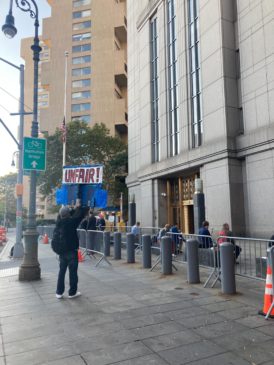CryptoX – Cryptocurrency Analysis and News Portal
Sam “SBF” Bankman-Fried took the stand this week to testify in his ongoing criminal trial in the Southern District of New York, denying any wrongdoing between FTX and Alameda Research, while acknowledging making “big mistakes” during the companies’ fast-paced growth.
His official testimony started on Oct. 27, after a hearing on the previous day without the jurors present. During the hearing, Bankman-Fried struggled to answer questions raised by government attorneys, whereas he appeared much better prepared the following day to face the jury.
A few highlights of Bankman-Fried’s testimony this week include denying directing his inner circle to make millionaire political donations in 2021, as well as claims that FTX’s Term of Uses covered transactions between Alameda and the crypto exchange. Moreover, the former CEO stated that he had requested additional hedging strategies for Alameda throughout 2021 and 2022, but they were never implemented.
The defense is expected to conclude Bankman-Fried’s examination on Oct. 30, followed by the prosecution’s cross-examinations and closing arguments from both sides. Prosecutors also hinted about a possible rebuttal witness next week — someone who is called to prove that the testimony of another witness is false or inaccurate.
Bankman-Fried could be jailed for 115 years if found guilty of all fraud and conspiracy counts. Cryptox’s on-the-ground coverage of his testimony is summarized below.
SBF refutes claims over political donations
Bankman-Fried denied in court having directing Ryan Salame, former co-CEO of FTX Digital Markets, and Nishad Singh, former director of engineering, to funnel millions of dollars in contributions to political campaigns.
According to data available on OpenSecret, Singh gave $8 million to federal campaigns in the 2022 election cycle. Salame also donated $10 million to politicians via loans from Alameda Research.
Even though Bankman-Fried denied instructing both to make political contributions, he recognized that lobbying in Washington, D.C. played a key role in his efforts to push a regulatory framework for crypto firms in the United States during 2021.
“I came to believe that I could impact the world.”
According to prosecutors, Bankman-Fried used funds from customers’ deposits on FTX to make more than $100 million in political campaign contributions ahead of the 2022 midterm elections.
Bankman-Fried denied any wrongdoing during his testimony, asserting that FTX had more than $1 billion in revenue in 2021 and that political donations were made from the exchange’s own funds.
Maxine Waters is chairing the investigation into FTX https://t.co/oFMctH4rRh pic.twitter.com/Ox6O5w4nOl
— Jordan Schachtel @ dossier.today (@JordanSchachtel) November 17, 2022
The New York Times test
Bankman-Fried had a guideline for employees’ communication at FTX and Alameda Research: The New York Times test.
Based on the informal test, employees should not write anything they wouldn’t be comfortable seeing on the front page of the newspaper. According to Bankman-Fried, even harmless things could “look pretty bad out of context,” so employees should be sure to always provide sufficient context in written messages.
Bankman-Fried described the test as part of his explanation of why more than 200 channels on Signal had an autodelete policy that permanently deleted messages after a week.
Prosecutors used evidence of the autodelete feature in the previous days to suggest that any wrongdoing between the companies was being covered up. According to Bankman-Fried, official communications and regulatory paperwork were handled through other channels, such as Slack or email, but Signal was the choice for daily communication within the companies.
Alameda’s unique role on FTX
Bankman-Fried provided details about Alameda’s billionaire line of credit with FTX. According to his testimony, Alameda served as FTX’s payment provider for wire transactions while the exchange was unable to have its own account.
Besides being a payment processor, Alameda was also the primary liquidity provider, market maker and a client of FTX.
As liquidity provider and market maker, Alameda would have to step in and cover customer losses if FTX’s risk engine failed. During his testimony, Bankman-Fried provided an example of a failure of the risk engine that resulted in Alameda covering millions of dollars in losses in 2021.
The nature of Alameda’s role in the exchange’s operations prompted custom features in FTX’s code, such as the ability to go negative via a line of credit without activating the risk engine. According to Bankman-Fried, the exemption was necessary to prevent Alameda’s potential liquidation, which would negatively impact the crypto markets.
As a client of FTX, Alameda was also able to borrow funds by depositing collateral in the exchange. The terms of use of FTX allow borrowers to use funds for any purpose, which means Alameda could trade with the borrowed funds.
Alameda’s line of credit with FTX grew along with the crypto industry during the bull market.
Alameda fails to hedge
Bankman-Fried discussed hedging strategies with Caroline Ellison, former CEO of Alameda Research, in 2021 and 2022 while seeking to shield the trading platform from a possible market downturn.
According to his testimony, Bankman-Fried asked Ellison to hedge $2 billion in Bitcoin (BTC) against a possible price decline in 2021. The strategy was never implemented, he told jurors.
Notes of Ellison shared as evidence by prosecutors reveal that Bankman-Fried was “freaking out” about hedging in early 2022. The defense used the evidence to illustrate that hedging was one of Bankman-Fried’s highest concerns and discussed with Ellison frequently.
Without appropriate hedging in place, Alameda was significantly harmed by the Terra ecosystem collapse and decline in crypto prices. In September 2022, Bankman-Fried learned the liability between the companies had grown from $2 billion a year before to over $8 billion.
“I was very surprised,” he claimed in court, stating that he believed Alameda’s assets outweighed its liabilities by nearly $10 billion.
Clawback provision in Terms of Use
According to Bankman-Fried, FTX’s terms of use include a clawback provision that would socialize losses among customers using margin trade and futures contracts in the event that the exchange’s risk engine fails.
The document presented in court states that:
“[…] your account balance may be subject to clawback due to losses suffered by other users.”
If FTX could not cover losses related to spot margins and futures, damages would be shared among all customers. Defense lawyers used the provision to argue that customers trading on FTX were aware of the risks involved.
The post Sam Bankman-Fried’s perspective on FTX fall appeared first on CryptoX.



